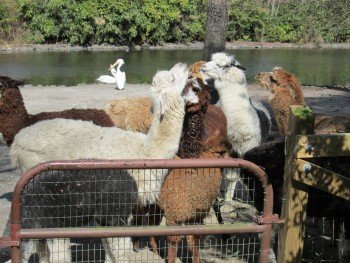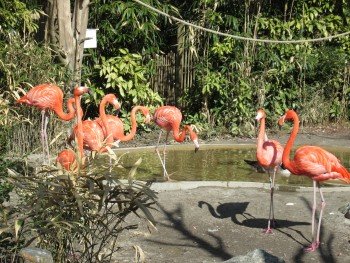Last Thursday was one of those perfect spring days. Between the sunny skies and the warm temperatures that we’ve been so desperately wishing for, we simply couldn’t sit inside the office all day. Fortunately for us, we had a behind the scenes tour of the Salisbury Zoo in the books, which was a highly anticipated Day Trippin’ adventure for us here at ShoreBread. Having grown up on the Eastern Shore, we are certainly no strangers to the Salisbury Zoo, but spending an afternoon at the zoo never gets old, especially when it’s a guided tour courtesy of zoo keeper Caleb Oliver. From the feeding of the animals to the fun facts, its safe to say that we’ve rekindled our love for the Salisbury Zoo.
Spring and late summer are an ideal time for a visit to the zoo, as the mild temperatures are conducive to most of the animals’ temperaments. Thursday’s weather was perfect, affording us with the chance to see nearly all of the animals out and about. Our first stop was to see the jaguars. The twosome spied on us skeptically from above, where they sat perched as Oliver explained that while many people assume that the jaguar need a larger space, the exhibit is purposefully designed vertically so that the jaguar have ample room for climbing.
From the jaguar we switched gears to pay a visit to the alpacas. Similar to llamas but with a thicker coat, the alpaca has been domesticated for so many years for their fur that there are hardly any left in the wild. After checking in on the guanaco (cousin to the llama), the llamas and the capybara, we stopped to feed the burrowing owls. The pint-sized pair were still too full to pay any attention to their afternoon snack, but Oliver noted that the birds are in fact quite feisty and aggressive. “When they feel threatened they can imitate the sound of the rattlesnake,” he added.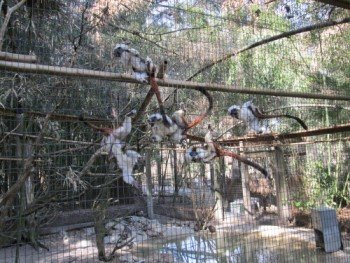
Up next, the cotton-top tamarins. These incredibly smart, fast and expressive creatures were particularly enjoyable to watch as they darted around their exhibit. Their faces are highly expressive and their quick movements made them difficult to photograph. Oliver noted that the tamarins are so fast and smart that it’s not uncommon for them to catch birds that fly into their exhibit.
On our way to the otters we stopped to pay a visit to a particularly outgoing ocelot. Oliver explained that while most ocelots are shy, the Salisbury Zoo resident was notably outgoing, which was evident by the way she strutted back and forth in front of us. Finally we reached the otters, one of the more popular exhibits at the zoo. The otters’ playful nature makes them a crowd pleaser at the zoo, as they swim and frolic for the audience. We were surprised to learn just how strong and sharp the teeth are. As we took a closer look Oliver stated, “their teeth are as sharp as a cats and as strong as a dogs.”
Oliver showed us some of the enrichment activities that the keepers typically practice with the otters, filling a large water jug with a few fish that the otter were then charged with finding a way to retrieve. Reminiscent of a dog with a Kong filled with treats, the otter worked intently to get their treats. The otter are dexterous, and while we knew they were great swimmers, we were surprised to learn that they are great climbers as well. Oliver noted that the otter actually get a large portion of their food while climbing trees. Another interesting fact, “ott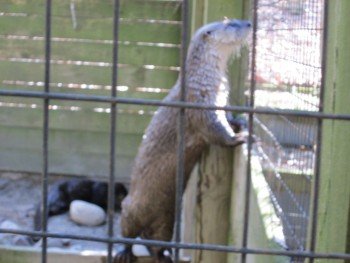 er are notoriously difficult to breed in captivity,” said Oliver, adding that they are feeling hopeful for a set of otter babies this year (we’ll keep our fingers crossed for that adorable zoo addition).
er are notoriously difficult to breed in captivity,” said Oliver, adding that they are feeling hopeful for a set of otter babies this year (we’ll keep our fingers crossed for that adorable zoo addition).
Behavior enrichment programs are common at the zoo and include various approaches for keeping the animals engaged and challenged. “Food is really the best enrichment because in the wild they would spend 80 percent of their time hunting and foraging and following their instincts,” said Oliver, explaining that by challenging the animals with food enrichment, it helps to simulate true life settings. Behavior enrichment also serves as a way to counter the development of negative captive behaviors, such as pacing or self-mutilation. By physically and mentally stimulating the animals with behavior enrichment the animals are able to live more fulfilling lives at the zoo, explained Oliver.
The Andean bears also enjoyed behavior enrichment during our tour. The exhibit is home to two Andean bears, one blind male and a female who Oliver described as “a little McGiver bear.” The incredibly smart female was quick to take to the enrichment activity. A closed box filled with treats was positioned high in a tree and she quickly scooped it up, parading it around for the crowd before finding 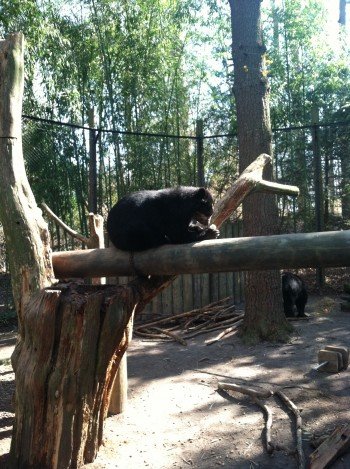 her way inside and rewarding herself with one of the large marshmallow treats. The box, which was sprinkled with cinnamon and bear grease, also served as a form of scent enrichment for the blind male bear. The Andean bear is more commonly known as the spectacled bear due to the special patterns of rings around the eyes that look like spectacles; however, Oliver noted that they are trying to get away from that misnomer as not all of the Andean bears bare that mark.
her way inside and rewarding herself with one of the large marshmallow treats. The box, which was sprinkled with cinnamon and bear grease, also served as a form of scent enrichment for the blind male bear. The Andean bear is more commonly known as the spectacled bear due to the special patterns of rings around the eyes that look like spectacles; however, Oliver noted that they are trying to get away from that misnomer as not all of the Andean bears bare that mark.
After bidding our new bear friends farewell, we made our way to the outback section of the zoo. Oliver explained that expanding the outback exhibits was one of the expansions on tap for the zoo after the completion of the new animal hospital, which is currently under construction. The alligator were sleeping of course, as they enjoy the tail end of their wintertime snooze. Alligators do very, very little during the cold months; in fact, alligators go through a process called brummation in which they slow down their metabolism drastically, resting their internal organs and forgoing food until it is warm out again.
While visiting the sloths we were intrigued to learn that baby sloths spend their entire first year of life hanging from their mothers. Sloths also have inverted hair that grows upside down due to the fact that they are hanging upside down so often.
The spider monkeys kept us entertained of course. Oliver explained that human contact with the monkeys is discouraged due to the risk of disease. Because spider monkeys have such a similar genetic make-up 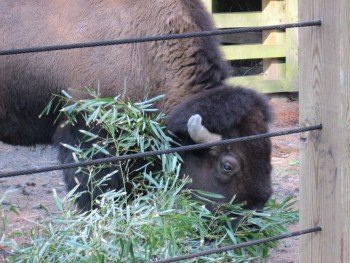 to humans, humans can actually catch illnesses or diseases from monkeys. Spider monkeys are also incredibly strong, said Caleb, estimating that they are roughly eight times stronger to scale.
to humans, humans can actually catch illnesses or diseases from monkeys. Spider monkeys are also incredibly strong, said Caleb, estimating that they are roughly eight times stronger to scale.
We rounded out our visit with a trip through the Delmarva Trail, spotting beaver, red wolves, deer and bison. The wolves and the bison were easy favorites for us, particularly watching the massive bison feast on a bamboo snack for an enrichment treat. We ended our tour with a fun fact: while there is a captive turkey residing at the zoo, the zoo is also home to a wild turkey that flew in for a few visits and never left!
As our tour came to an end and the zoo keepers went about closing up the park for the day we left with an abundance of zoo knowledge, a collection of photos and the determination to not wait so long next time before returning to the Salisbury Zoo for another Day Trippin’ adventure.
